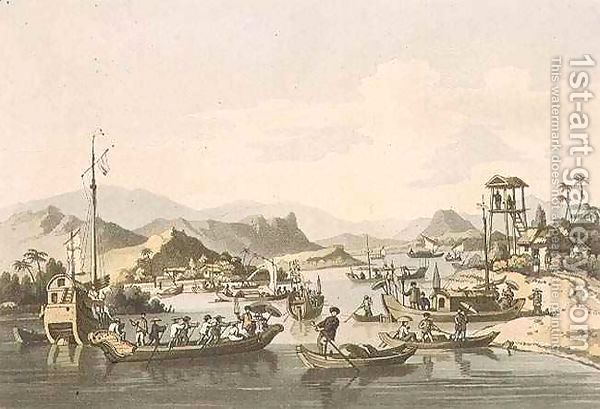Western witnesses of Vietnam’s sovereignty over Hoang Sa In the 15th century, Western missionaries and traders set foot in the "mysterious East". In  A merchant ship passes through the East Sea of Vietnam – picture by John White. Hoang Sa - Truong Sa in a search for colonies In 1494, Pope Alexander VI divided the newly discovered lands outside Europe to Portugal and Spain along a meridian 370 leagues west of the Cape Verde islands (off the west coast of Africa), through the Treaty of Tordesillas. This line of demarcation was about halfway between the Cape Verde Islands (already Portuguese) and the islands entered by Christopher Columbus on his first voyage (claimed for Spain), named in the treaty as Cipangu and Antilia (Cuba and Hispaniola). The lands to the east would belong to The merchant ships of Portuguese navigator Fernão Mendes Pinto, who was also a Jesuit, recorded his journey to the In the book Pinto described the Hoang Sa Archipelago in detail. He called it Pulo Pracelar. In Portuguese, Pracelar means coral and Pulo means islet. The Western missionaries joined merchant ships to go to In the 17th century, the Portuguese lost their monopoly in the In the 18th century, the  European merchant ships in Hoi An in the 17th century. The French, through the activities of the missionaries and merchants, were interested in and had better knowledge about Bishop Pigneau de Béhaine was well aware of the political situation in Tonkin and The French missionaries on the ship Amphitrite, on their way to Western witnesses  The map of An Nam by Bishop Jean-Louis Taberd with Hoang Sa and Truong Sa. Frenchman Jean Baptiste (1769 - 1825) was called in Vietnamese Nguyen Van Thang and appointed as a marquis by King Gia Long. His memoir titled "Le Memoire sur la Cochinchine" wrote: "Cochinchina, of which the sovereign king today carries the title of Emperor, includes Cochinchina proper, Tonkin: a few scarcely inhabited islands not far from the coastline and the Paracel archipelago made up of islets, coral reefs and uninhabited rocks. It was in 1816 that the present Emperor (Gia Long) took possession of this archipelago." In 1837 the Reverend Jean-Louis Taberd, then Bishop of Isauropolis, wrote the following in his "Note on the Geography of Cochinchina” printed in the Journal of the Royal Asiatic Society of Bengal, India: "The Parcel or Paracels is a labyrinth of small islands, rocks and sand-banks, which appears to extend up to the 11st degree of north latitude, in the 107th parallel of longitude from “Parcel or Paracels (Bai cat vang), although this archipelago has nothing but rocks, beaches and great depth promising more disadvantages than advantages, Emperor Gia Long thinks of expanding his territory by occupying this bleak land. In 1816, he visited the site, solemnly planting the flag, formally taking possession of these islands without anyone disputing him.” In the Vietnamese – Latino dictionary title "Latino - Anamiticum" by bishop Taberd published in 1838 there is the map titled "The Map of Annam" in the three languages of Latin, Chinese and Quoc Ngu. In this map, the Paracels (Cat Vang, Hoang Sa) is located in For his part, J.B. Chaigneau, the counselor to the Emperor of Annam, wrote in the memoir on Cochinchina: “The country of Cochinchina, whose emperor has just ascended to the throne, includes the regions of Cochinchina and Dubois de Jancigny wrote in his book “The world, history and description of the peoples of Gutzlaff in his article “Geography of the Cochinchinese Empire” published in 1849 in London (UK) also recorded Cát Vàng (to indicate the Paracel) of Cochinchina. Gutzlaff wrote: “Whether it is because of the coral animals or of other causes that these rocks have because gradually bigger, but one thing is clear that the islets rise every year higher and higher, and some of them are now permanently inhabited, through which the waves, only a few years ago, broke with force. They would be of no value if the fishing job was very productive, and did not remunerate all the perils of the adventurer. From time immemorial, junks coming largely from Hainan have annually visited all these shoals, and proceeded in their excursions as far as the coast of In Italy’s Geography Summary (Compendio di Geografia) compiled by Adriano Balbi in 1850, page 641 describes the geography of the Kingdom of Annam: Also belonging to this Kingdom is the Paracel archipelago, Pirati Islands and Poulo Condor Islands (i.e. the Hoang Sa archipelago, the clusters of Hai Tac Islands and Con Dao Islands). Also in this work, from pages 644-648 written about Chinese geography, no mention was made about Hoang Sa and Truong Sa. Duy Chien, The article uses research materials by Dr. Han Nguyen Nguyen Nha, founder and advisor of the Cultural Education Fund in |
↧
Article 8
↧